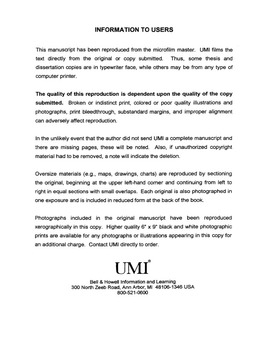| dc.contributor.advisor | Gipson, Richard, | en_US |
| dc.contributor.author | Hillbrick, Julia Rae. | en_US |
| dc.date.accessioned | 2013-08-16T12:30:34Z | |
| dc.date.available | 2013-08-16T12:30:34Z | |
| dc.date.issued | 1999 | en_US |
| dc.identifier.uri | https://hdl.handle.net/11244/5833 | |
| dc.description.abstract | The snare drum was the instrument the respondents felt most comfortable with after their class. The timpani followed with keyboard percussion and accessory instruments rated equally in third place. A significant drop in percentage followed with drumset and marching percussion. Most respondents did not receive any instruction in these areas and those who did indicated they were not well prepared for the challenges they faced. Of the non-musical aspects in the questionnaire, the respondents indicated they would have liked to receive more information surrounding instrument maintenance and repair. | en_US |
| dc.description.abstract | In 1994, the Percussive Arts Society (PAS) formed a committee to create standards for the percussion techniques class that were based on suggestions from percussion instructors who had taught the class. This list provided a foundation of basic knowledge from which instructors of the class could create or evaluate a syllabus. The point of view, however, was that of the instructor of the class. Opinions from the student were not included. In contrast, the questionnaire developed for the current research ought only the opinions of former students. | en_US |
| dc.description.abstract | Overall, the respondents indicated the class was average in preparing them for the work field. However, this research indicates current percussion techniques classes in the states of Illinois, Missouri, and Wisconsin are not meeting the minimum standards set by the PAS committee mentioned earlier. The areas of concern focus on drumset and marching percussion. Future instructors should evaluate their syllabus relating to these areas if this problem is to be remedied. | en_US |
| dc.description.abstract | The percussion techniques class is a methods course designed to teach future music educators about percussion and is required in most college music education curriculums. This research project aimed to study the effectiveness of the percussion technique course in preparing students for the work field as instrumental ensemble directors. A questionnaire was developed to survey 2,258 MENC (Music Educators National Conference) members currently directing instrumental ensembles in junior higher high school in the states of Illinois, Missouri, and Wisconsin. These directors presumably took this class during their college music education. The survey was designed to compare the information these former students received in class with the information they now know would be useful as an ensemble director. | en_US |
| dc.description.abstract | The questions in the document centered around instrument categories. After introductory and biographical questions, the respondent was able to indicate if he/she received information about a certain instrument-related element and if that element was being utilized in their respective teaching situation. If the element was being used in their teaching, they were then able to indicate how effective the instruction had been on that element. | en_US |
| dc.format.extent | xi, 177 leaves ; | en_US |
| dc.subject | Education, Music. | en_US |
| dc.subject | Psychology, Clinical. | en_US |
| dc.subject | Percussion instruments Instruction and study. | en_US |
| dc.subject | Music teachers Surveys. | en_US |
| dc.title | A profile of the perception of instrumental ensemble directors in the states of Illinois, Missouri, and Wisconsin regarding the percussion techniques class. | en_US |
| dc.type | Thesis | en_US |
| dc.thesis.degree | D.M.A. | en_US |
| dc.thesis.degreeDiscipline | School of Music | en_US |
| dc.note | Adviser: Richard Gipson. | en_US |
| dc.note | Source: Dissertation Abstracts International, Volume: 60-06, Section: A, page: 1954. | en_US |
| ou.identifier | (UMI)AAI9934632 | en_US |
| ou.group | Weitzenhoffer Family College of Fine Arts::School of Music | |
